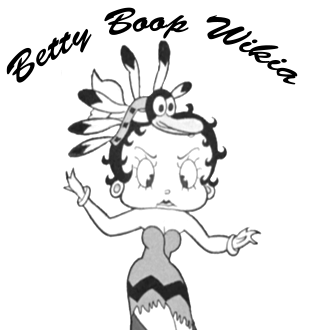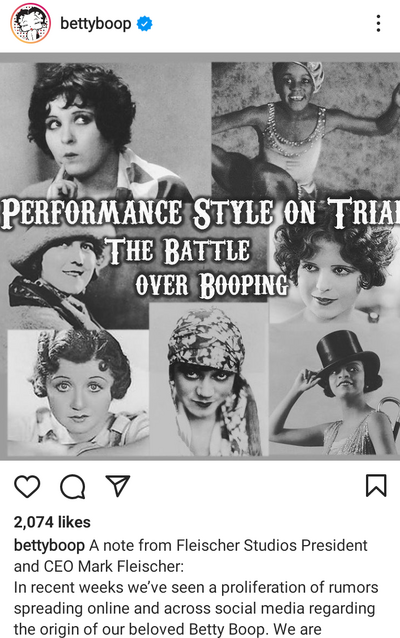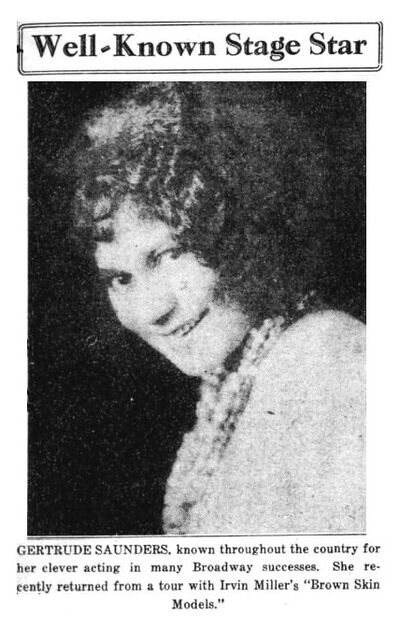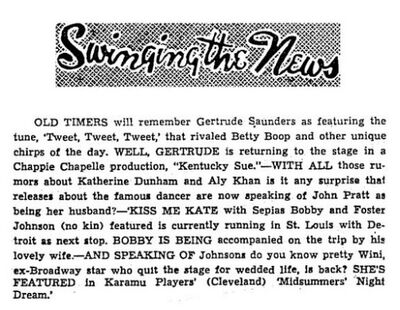This article is about Gertrude Saunders. See Baby Esther Jones for the Child Wonder.
Gertrude Saunders
| Gertrude Saunders the Tweet-Tweet-Tweet Girl |
|---|
| Gertrude Saunders | |
|---|---|
 | |
|
Name |
Gertrude Saunders |
|
Audio: |
Gertie Saunders scat singing (1921-1945): |
Gertrude C. Saunders[1] (born March 25, 1903 - April 1991) was a singer, actress, dancer and producer of musicals and vaudeville shows. Her most renowned performance was as the original star of the avant-garde "Shuffle Along" show.
Saunders was born in Asheville, North Carolina. As a teenager, in her senior year at Benedict College in Columbia, South Carolina, she left the school to go on tour with vaudeville and stage performer, Billy King. In history, Saunders is infamously known for her affair with Bessie Smith's husband, Jack Gee.
She became a member of the Billy King Stock Co., which for a number of years was housed in Chicago's Grand Theater. "Wait Til the Cows Come Home" from The Board of Education in 1918, "Little Lump of Sugar" from The Heart Breakers in 1918, "Hot Dog" from They're Off in 1919, and "Rose of Washington Square" from Town Top-Piks in 1920 were among the hits that she made while working with Billy King. Her other stage credits include The Face at the Window, Raiding a Cabaret, The Undertaker's Daughter, and At the Beach in 1917; In the Draft and At the Beach in 1918; and Over the Top and Exploits in Africa in 1919.
Since it "dramatized the state of African Americans at the time of the Paris Peace Conference" and was among the earliest well-known attempts to present serious theatrical and musical revues, Over the Top was a noteworthy production.
Saunders was a soprano singer, which is the highest female voice type, and she was the first Black woman to appear at the Winter Garden, there she was presented by Will Marion Cook.
After Florence Mills replaced Saunders as the lead in Shuffle Along, Saunders worked in revues throughout the 1920s and 1930s, including one financed by Bessie Smith’s husband, Jack Gee in 1929, which led to a fight with Smith. In 1931, Saunders experienced a nervous breakdown and returned to her home in Ashville, North Carolina, to recover.
She returned to performing in the vaudeville Keith circuit as well as other White circuits, she also co-produced her own show, Midnight Steppers in 1939. She was also featured in revues such as Red Hot Mama.
She made a pronounced hit with her "urban blues". According to one reviewer, "Jazz with more pep than ever seen here before was featured by Gertrude Saunders with her singing of 'Daddy' the show was stopped for ten minutes or more."
Saunders was the antithesis of Bessie Smith, their personalities and looks contrasted sharply.
According to Bessie Smith's niece Ruby, Gertrude was the opposite of Bessie Smith, making no secret of her disdain. "She had light skin and long curly good hair and a gorgeous figure, and she knew it. In fact, she thought her poop didn't stink." According to some Black critics, in Saunders' earlier career she was never really that good of a singer, and she used to sing in a "loud high-pitched wailing" voice, and more or less relied on how she looked.
In her 1921 debut, the Caucasian press gave Saunders great reviews, whereas some of the Black press gave her bad reviews. Black critics, indicated that Saunders earlier "vocals" were intended for to entertain "white" audiences. One Black reviewer wrote an in-depth review and described Saunders as sounding more "Caucasian" in comparison to someone like say Bessie Smith.
Gertrude later "lowered the pitch" of her voice in her routines, sounding somewhat similar to her rival Bessie Smith.
A 1921 Billboard article said that Saunders' quaint singing methods did not "just happen." She dared to be different and won at it. Billboard also went on to say in another article that Saunders was a "positive sensation" and the critic said that he had never heard the human voice perform such "amazing tricks", nor had he listened in a long time to a single woman who landed a song with such astounding mannerisms and to such hilarious approval.
The writer for Billboard wrote in that very article, that other Caucasian singers, should "copy" Saunders. And if they hadn't been vamped by brown skin, they should be. And that he craved to hear Saunders' vocal fireworks again.
On Saunders' 1923 recordings of "Potomac River Blues", and "Love Me" she sings in a more higher pitched baby voice, with "scat sounds" included.
On Sunday, November 6 in 1927, Saunders and and thousands of all races and ranks thronged Harlem streets and avenues for the paying of the last tribute of love and admiration to the dainty little comedienne, singer and dancer Florence Mills, over 50,000 viewed Mills' body. Saunders appeared at Mills' funeral as an honorary pallbearer, with a group of actresses including Edith Wilson, Cora Green, Evelyn Preer, Ada Ward, Maude Russell, Lena Wilson and Ethel Waters.
Saunders' early experiments with scat singing with the "Tweet-Tweet-Twat" and other scat trills are said to have inspired other female singers of the 1920s and 1930s. Saunders' "Tweet" was that of a bird chirp, mixed with cooing, chirping and scat-singing.
During the $250,000 Infringement Lawsuit, the Afro-American newspapers claimed that Helen Kane had coined Saunders' scat-singing routine, and dubbed Saunders the unofficial original "Boop-Boop-a-Doop" girl from 1934 up until the 1950s.
Saunders told newspapers that she had already used the baby-talk long before Helen Kane, while headlining as part of the 1921 musical Shuffle Along, and she stated that "Poo-Poo-Pah-a-Doop" had originated in her number "Daddy Won't You Please Come Home," ending the entire scat chorus in baby-talk.
In a 1938 article, it was said that Gertrude started "Boop-Poop-a-Dooping" before Helen Kane, and prior to coming to the Negro Unit of Federal Theatres Project, Saunders was a feature attraction at the Hollywood and Kit-Kat nite clubs.
Saunders played a maid called "Yellow Marie" in the 1938 Metro-Goldwyn-Mayer movie The Toy Wife. The stereotypical joke in the film is that, there was a "Brown Marie", so Saunders was "Yellow". She was shown in a better light in the 1945 film Big Timers the 1947 film Sepia Children, which were both marketed toward Black audiences.
According to blues singer Alberta Hunter, who was a really good friend of Saunders, she stated that Saunders later became a "voice-over artist" for animated cartoons, however it is not known in history what cartoons Saunders lent her voice to. She also stated that Saunders was the first "Black woman" in the entertainment industry to invest real estate, and that Saunders later became a "landlady" fighting her tenants in court.
In mainstream media, Saunders is deemed a "homewrecker", for example in the 2015 film Bessie, she was shown in a bad light, and the film didn't show off Saunders' talent, and she was dubbed the "Yellow" girl who stole Smith's husband Jack Gee.
Cartoon character Betty Boop has numerously used Saunders' "Tweet-Tweet-Tweet" technique in cartoons such as I Heard, Betty Boop's Hallowe'en Party and The New Deal Show. Coincidentally Florence Mills who went on to inspire child star Baby Esther Jones, used a "Tooty-Tooty-Too" in her songs.
Nippon Betty Boop also used Saunders technique in her "Tweet Tweet Tweet" recording. Helen Kane later used Saunders' "Tweet-Tweet-Tweet" in her song "When My Sugar Walks Down The Street" released in 1954.
Rose Murphy, often known as the Chee-Chee Girl, was an African-American jazz vocalist who outperformed Saunders in that category during the 1950s. Murphy was that popular, that she became Helen Kane's rival and both appeared on Ed Sullivan's show.
In the award winning 2016 revival of Shuffle Along, Gertrude Saunders was portrayed in a more positive light by Adrienne Warren. In the same musical Warren also played the role of Florence Mills, Saunders' successor.
The review for Warren's portray by Broadway World stated, "First she's the exuberant Gertrude Saunders, whose cutesy singing style would be popularized to the white mainstream by Helen Kane, the model for the iconic Betty Boop. When Saunders leaves the show, Warren immediately re-enters as the shy Florence Mills who would grow into one of the great singing artists of her time."
Quotes
- Gertrude Saunders: "I closed with ‘Shuffle Along’ two weeks ago and am now entertaining at Reisenweber's." (Chicago Defender, 1921)
- Gertrude Saunders: "I made a moving picture since leaving ‘Shuffle Along,’ and also made two records last week." (Chicago Defender, 1921)
- Gertrude Saunders: "Nudity is all right if you have something to show. My role in Red Hot Mama suits me to a 'T'. I love it." (Pittsburgh Courier, 1928)
- Gertrude Saunders: "Florence Mills sang a song with soul. I was a trickster. I just did tricks."
Fleischer Studios (2021)
Gertrude Saunders is one of the several "scat singing" performers to be given tribute by the Fleischer Studios and official Betty Boop page in 2021. You can find out more by clicking "The Battle Over Booping" and following the link to the Fleischer Studios article.
Gertrude Saunders and Baby Esther
Gertrude Saunders and Baby Esther were not the same person at all. Saunders is frequently misidentified as Gertrude Saunders. She was older than Baby Esther, and used the "scat singing" technique long years earlier. Other publications credit Mae Barnes, a singer and dancer, who "Boop-Boop-a-Dooped" a lot of "Boops" before Helen Kane even heard of the "Boop". Barnes made an appearance in the 1927 Broadway musical Shuffle Along.
Scat Sounds Originated by Saunders
- Tweet-Tweet-Tweet
- Twa-Twa-Twa
- Tweet-Tweet-Twat
- Ska-La-De
- Scoodly-Da
- Booly-Boo-Roo-N-Toodly
- Wa-Wa-Wa
- Wa-Wa-Wa-Wa-Wa-Wa-Wa
- De-De-De-De-De-De-De-De
- Rooden-De-De-Do-De-Rooden-De-De
- Dooden-De-De
- Roo-Dooden-De-De
- Skee-Ripple-Skee-Rubble
- He-Den-De-Dee
- Rrr-Ree-Rrr-Rrr-Rrr
- Rom-Bo-De
Gertrude's Successor Florence Mills
Gertrude's successor was Florence Mills. Florence started her career as Baby Flo, she became famous replacing Gertrude in the musical Shuffle Along. Gertrude, in spite of the efforts of persuasion, left the show. Saunders was adamant in later years that she "never missed a thing by walking out of Shuffle Along." Mills who was a versatile entertainer who also excelled at dancing, died in 1927 and left behind no recordings. In 1928, child entertainer from Chicago Baby Esther took on Mills' persona and started impersonating her on stage, and became successor to Mills. Esther Jones had several name variations, and was also known as the miniature Florence Mills.
Gertrude Saunders Ran Away From College For Stage (1924)
Gifted comedienne with Dinah hooked school in fourth year to carve out stage career. Those who have been enjoying the delightful singing of Miss Gertrude Saunders, do not know that higher education once made a bid for her talent. Miss Saunders was only seventeen when the decision was made that spoiled, forever, a possible prim and prudish scholar. She was in her fourth year and through her stay at school had been the idol of her fellow students. Her natural born talent of humor kept her forever doing comical things. Her fellow students, sensing her superior gift, often urged her to take up stage work. Her success was noted and she was engaged for the original Shuffle Along show preceding Florence Mills as the feminine star.
Gertie Held Up! (1927)
In 1927 Gertie was assaulted by three men at Sixteenth and Lombard streets and robbed of $240 in addition to being severely beaten. Police later arrested three men on Miss Saunders identification. It was known that she was receiving a large salary and that she had been wearing many valuable rings. Following the close of the performance Miss Saunders left to walk to the Douglass Hotel, where she was a guest. Two men jumped from a slowly moving motor and struck Miss Saunders in the jaw and stomach. As she fell, they grabbed her purse and jumped into the car. The little singer, who is noted for her aggressiveness crawled to her feet and as her head cleared saw the automobile moving away. She ran after it and when she turned two men tried to stop her, but she broke loose from them with the sleeve of her coat being torn in the tussle. When a cop appeared Miss Saunders preferred charges against the driver, then in the crowd she saw two of the men who had grabbed her and pointed them out and they were taken into custody.
Gertrude Saunders Sweetie Dismissed (1927)
Musical comedy star says boyfriend beat her up and wouldn't give up keys. Second beating, actress also says she gets $600 weekly salary. Exhibiting scars and bruises on her face and body, which she says caused her excessive pain, Gertrude Saunders, famous "Red Hot Mama", appeared in Magistrate McQuade's Heights Court and preferred charges of disorderly conduct against her sweetie, James Evans, billiardist and Beau Brummel. Sheik beat her. Gertie then unfolded to Magistrate McQuade a tale of woe in which she declared that Evans, who had been living with her, had brutally beaten her and when she had requested him to move had refused to turn over the apartment keys to her. "Judge, your honor," she said. "I want this man to refrain from beating me and to move out of my apartment." When asked what the trouble was, Evans stated that he had taken care of Miss Saunders but that she did not appreciate it. His statement enraged Gertie and she shouted, "I make more than $600 a week and am perfectly able to take care of myself. Judge I want my keys and I never want to see him again." After considering the case, the magistrate decided that since the apartment was occupied by Miss Saunders and as Evans was paying her no rent, he should turn over the keys and the charge of disorderly conduct was dismissed.
Gertrude Saunders Retires After 11 Years On Stage (1928)
Gertrude Saunders the star of Irvin C. Miller's Bad Habits of 1928 is the stages wealthiest actress, and has thousands in jewels and automobile. The star of a number of New York successes said that the stage is the surest and quickest way to make money. "I have found out by experience," said Miss Saunders, "that the better a woman carries herself on the stage, the better people like her." Miss Saunders was born in Asheville N.C and received her school training at Benedict College, Columbia S.C. Miss Saunders' first trial on the stage came in the chorus of Billy Fang's show back in 1916. Her work was of such noticeable merit until she soon worked in a principal role. Then when Billy King moved into stock, Miss Saunders' name became a headline as one of the coming new stars. Then came Shuffle Along, Liza and a turn or too over the K-A and Orpheum circuit and every thing was hotsy-totsy for Gertrude, as she is now called by hundreds of admirers. Miss Saunders has $4,000 worth of jewels, running in four figures. She recently purchased a $7,000 McFarland automobile, and among her friends is said to be the wealthiest actress on stage today. Miss Saunders has been on the stage eleven years and expects to retire at the close of the present engagement. Her mother Mrs. Mary Daly, resides at Asheville. N.C.
Sign Gertrude Saunders For "Blackbirds" Company (1928)
Lew Leslie's Blackbirds moved from the Liberty to the Eltinge Theatre. Monday, with several added features. Mr. Leslie has announced that he has signed Gertrude Saunders, actress and singer for one of the leading roles inthe Boston company of Blackbirds.
Gertrude Saunders At Royal Next Week (1928)
The Dixie Vagabound starring Gertrude Saunders wil lcome to the Royal Theatre next week following directly behind its New York run.
Well-Known Stage Star (1930)
Gertrude Saunders, known throughout the country for her clever acting in many Broadway successes. She recently returned from a tour with Irvin Miller's "Brown Skin Models."
The Original Boop-Boop-a-Doop Girl (1934)
A 1934 Afro-American newspaper dubbed Saunders, "The Original Boop-Boop-a-Doop Girl". In a 1938 Afro-American newspaper, it was declared that Gertrude debuted at the Cotton Club and that she was figured prominently at the $250,000 Infringement Lawsuit of Helen Kane and Betty Boop, who both claimed they originated the funny twist which was a radio rage.
Big Timers (1945)
Gertrude made an appearance in the 1945 musical Big Timers where she sings Bessie Smith's 1928 hit song "Yes Indeed He Do," the only difference is in Gertrude's version of the song, she adds her scat singing. While performing the song Gertrude makes funny faces (something Baby Esther Jones used to do in her cabaret shows), rolls her eyes and starts scat singing, while scatting she avoids using "Boop-Boop-a-Doop" and instead uses a "Tweet-Tweet-Tweet" among several other scat sounds and trills.
Bessie Smith's version of "Yes Indeed He Do".
Broadway Comeback (1950)
Gertrude "Tweet-Twat-Tweet" Saunders, noted blues singer, whose dancing the Charleston and singing "Sweet Georgia Brown" in the musical show Runnin Wild is destined for a comeback on Broadway, according to recent indications.
The once famous soubrette of a few seasons back when Negro show biz was at its peak, Gertie was one of the spectacular actresses of the golden era.
Miss Saunders will be seen in the all-sepia musical show Kentucky Sue now in rehersal, under the direction of Chappie Chappie, well known actor-producer, and scheduled for opening next month. After a long absence from Broadway, Miss Saunders returned from the West Coast, after being engaged in motion picture work in Hollywood, and has accepted a major role in a new vehicle.
It will be remembered by many that Gertrude Saunders is conceded to be the originator of the "Boop da Boop" jazz obbligato made famous by Helen Kane, and more recently a novelty so prevalent with such stars as Judy Cannova, Ella Fitzgerald, Rose "Chi Chi" Murphy and others.
Miss Saunders introduced the novelty "Tweet-Tweet-Twat" at the old Grand Theatre, Chicago, when she was in vaudeville, which is just a melodious expression of happiness and elation. Gertie shared honors with the late Florence Mills, who were the first Negro stars (female) whose names were illuminated in the gay white way, when she was appearing at Reisenwebbers, Columbus Circle.
Betty Boop's Rival (1950)
Old timers will remember Gertrude Saunders as featuring the tune, "Tweet, Tweet, Tweet," that rivaled Betty Boop and other unique chirps of the day. Well, Gertrude is returning to the stage in a Chappie Chapelle production, "Kentucky Sue."
Death
- Gertrude died in Beverly Massachusetts in 1991.
Gallery
Trivia
- Gertrude was featured on the song sheet for the "That Da-Da Strain", a song by Clarence Williams, who claimed himself to be the creator of "hot licks".
- Saunders made her first record for OKeh in April 1921, when Shuffle Along was just getting started. It preserves her two hit numbers from the show, "I'm Craving for That Kind of Love" and "Daddy, Won't You Please Come Home."
- Gertrude was last referenced in June 1950 as originator of "Boop-da-Doop" made famous by Helen Kane.
- There is no solid proof to back Gertrude's claim of being the black gal headlined in the lawsuit, apart from her stating that the $250,000 infringement lawsuit was about her.
- Gertrude Saunders was recognized at an event sponsored by the Negro Actors Guild of America, with fellow entertainers Josephine Baker, Eubie Blake, and Noble Sissle.
- In the 2015 Bessie Smith TV Movie, Gertrude Saunders was portrayed by actress Chantelle Rose Mussenden.
- Gertrude had the exact same title "Queen of the Blues" as Bessie Smith.
- Betty Boop uses Gertrude Saunders' "Tweet Tweet Tweet" and "Twa Twa Twa" in I Heard and The New Deal Show.
See Also
- Black Betty Boop
- Gertrude Saunders the Original Boop-Boop-a-Doop Girl (1934)
- Negro Booper (1938)
- Gertrude Saunders Gets A Break (1939)
- Gertrude Saunders Returns to Broadway (1950)
- Gertrude Saunders Broadway Comeback (1950)
- Remember Gertrude Saunders? (1950)
- Betty Boop's Rival Gertrude Saunders (1950)





















